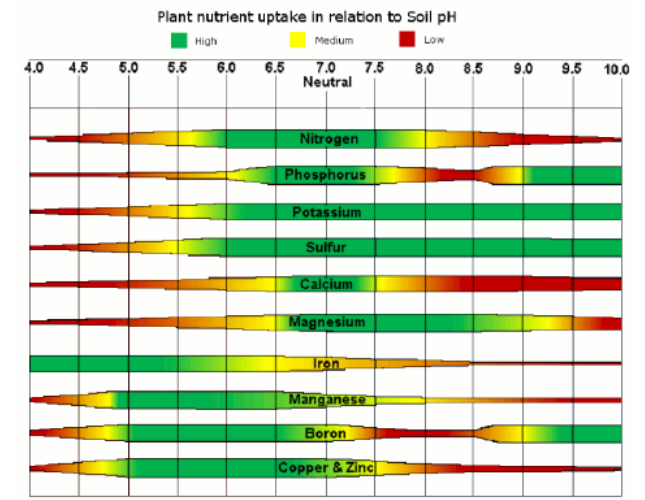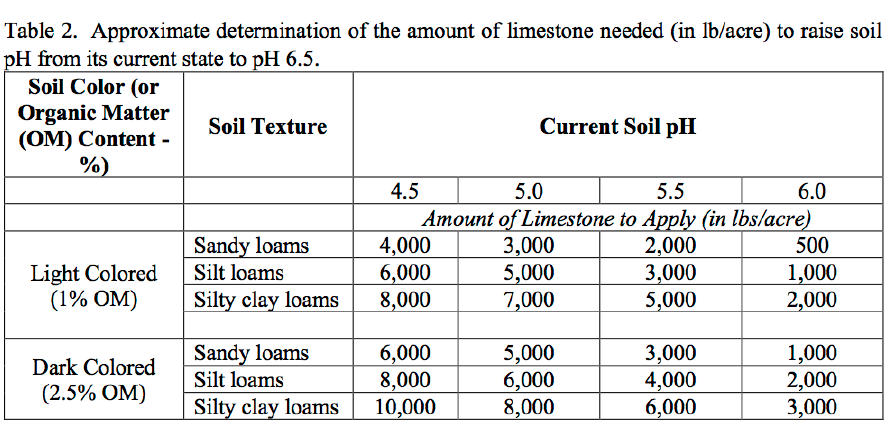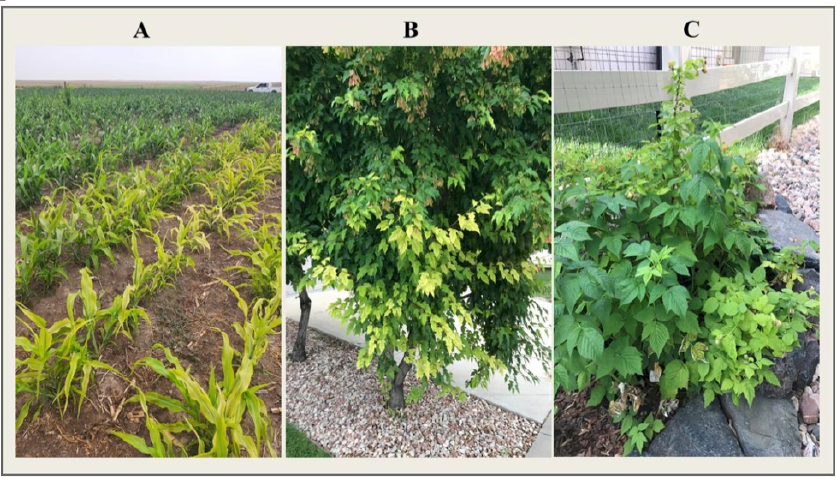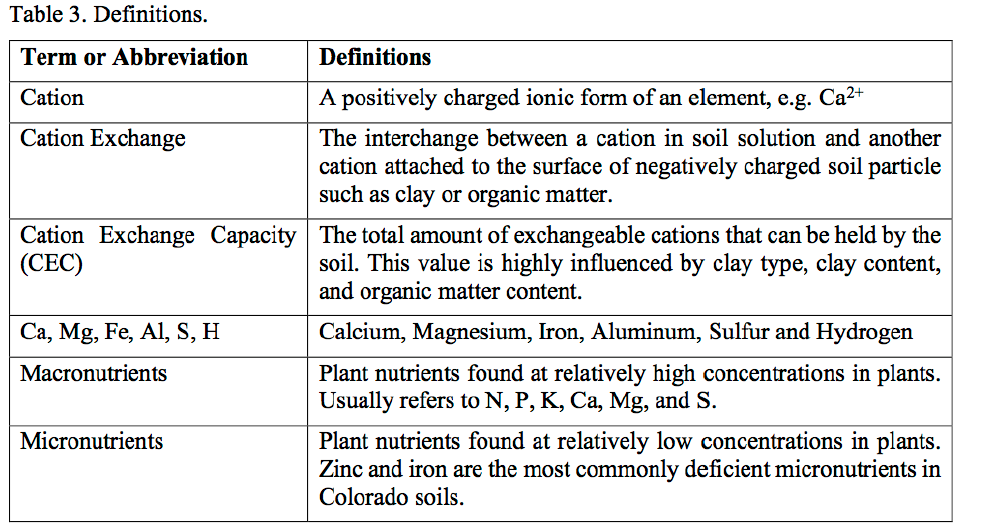By Jim Ippolito and Troy Bauder
Quick Facts…
- pH is the measure of soil acidity or alkalinity.
- Raising soil pH is relatively easy.
- Lowering soil pH is difficult, and in soils containing large quantities of lime (i.e., calcium carbonate), nearly impossible as well as cost prohibitive.
Soil pH and Soil Nutrient Availability
Soil pH describes whether a soil is acidic, neutral, or basic. The pH scale ranges from 0 (very acidic), to 7 (neutral),to 14 (very basic). The pH of most soils used for agricultural production within the US range between pH 5.5 and 8.However, most Colorado surface soils used for agricultural production have pH values between 7.0 and 8.2, although soil pH may be outside of this range depending on the geologic material under which the soil has formed and management practices utilized overtime.
Soil pH values above 8.5 are rare, but may indicate problems such a as imbalance between low exchangeable calcium (Ca) and high exchange able sodium (Na), called sodicity. Soil pH directly or indirectly affects plant-available macro- and micronutrient concentrations. As shown in Figure 1, the areas in green, yellow, and red indicate relatively high, medium, or low nutrient availability concentrations as a function of pH. The pH value where most of these nutrients are maximized is approximately pH 6.5. Knowing this information begs the question from many producers and home gardeners: how do I alter soil pH?
Raising Soil pH
One would want to raise soil pH if acidity is an issue for raising crops. The most common approach to neutralizing soil acidity, and thus raising soil pH, is through the addition of a liming agent. A good liming agent must perform two jobs. First, it should remove acid generating ions (typically H, Fe, and/or Al) from soil surfaces (called cation exchange sites) by replacing those ions with basic cations such as Ca or Mg. These acid generating ions are released into the soil solution.
The second critical job of the liming agent is to neutralize the acidity added to soil solution by these ions. Several liming materials are available at garden centers and co-ops, with their effective acid neutralizing ability always based on an equivalent basis to calcium carbonate (i.e., the benchmark liming material). This is known as a liming materials’ calcium carbonate equivalency, and is essentially based on the ratio of the amount of Ca (and/or Mg) to other elements present in the liming agent in relation to calcium carbonate. A list of common liming agents and their calcium carbonate equivalencies are presented in Table 1.


The amount of lime to add varies depending on soil texture, cation exchange capacity (i.e., the amount of positively charged nutrients a soil can hold), and organic matter content. Based on these soil properties, a soil testing laboratory can determine a soil-buffer pH test to show you the change in soil pH based on lime application. The most common test used for Colorado soils is called the Shoemaker-McLean-Pratt (SMP) Buffer method.
If you have a lab determine the soil- buffer pH, ask the laboratory to also determine the amount of limestone needed to raise your soil pH to the desired pH; laboratories routinely provide these types of recommendations. A rough rule of thumb for quickly determining the amount of limestone required to raise soil pH from a current value to pH 6.5 is presented in Table 2

Lowering Soil pH
Lowering the pH of alkaline soils is typically desired to reduce iron deficiency symptoms (e.g., Figure 2). However, in soils containing naturally-occurring lime, it is difficult to impossible, cost prohibitive, and thus impractical to lower soil pH. To test for the presence of lime, add some vinegar to dry soil; the formation of bubbles, or fizz, indicates the presence of lime. When this occurs, lowering soil pH is impractical. To emphasize this point, if the top 6 inches of soil contains 2% lime, that equates to 20 tons of lime per acre and would require ~ 6.5 tons of elemental sulfur (S) per acre; this would only neutralize the lime in the top 6” (not deeper depths) and not additional alkaline sources on soil cation exchange sites.
Lowering the pH of soils that do not contain lime requires the addition of elemental sulfur (S); do not add gypsum (CaSO ) as it is not an acidifying agent. In the presence of oxygen, water, and soil microorganisms, elemental S will be converted to sulfuric acid (H SO ) to help lower soil pH. A general guideline is to add about 650 lbs of elemental S per acre to lower soil pH by one unit. Keep in mind that:
- fine textured, clayey soils and soils above pH 7.3 likely will require greater elemental S rates;
- incorporating elemental S to a soil depth that needs acidifying is necessary and will help speed up the conversion of elemental S to (H2SO4)
- conversion of S to H2SO4 is dependent on soil moisture, temperature, and soil microbiological activity, and thus may take several months to a year to occur; and
- monitoring soil pH several months to a year after initial application, and re-applying elemental S on a yearly basis may be needed to help reduce and reach a target soil pH.


References
- Colorado Master Gardener GardenNotes #222. Soil pH. Available at: https://cmg.extension.colostate.edu/Gardennotes/ 222.pdf
- University of Wyoming Extension B-1358. Alkaline soils in Wyoming. Available at: http://wyoextension.org/publications/html/B1358/
- K-State Research and Extension. Acidifying your soil. Available at: https://www.riley.k-state.edu/docs/lawnandgardenandother/Acidifing%20Your%20Soil.pdf
- Utah State University Extension. Managing soil pH in Utah. Available at: https://www.riley.k-state.edu/docs/lawnandgardenandother/Acidifing%20Your%20Soil.pdf
- Montana State University Extension. Soil acidification: Problems, causes, & testing. Available at: https://landresources.montana.edu/soilfertility/doc uments/PDF/sscoop/SoilAcidifProbCauseTestSS.pdf
- Oregon State University Extension publication EM 8917-E. Acidifying soil for crop production: Inland Pacific Northwest. Available at: https://catalog.extension.oregonstate.edu/sites/catalog/files/project/pdf/pnw599.pdf
- Colorado State University Extension #0.521. Diagnosing Saline and Sodic Soil Problems. https://extension.colostate.edu/docs/pubs/crops/0 0521.pdf
Colorado State University, U.S. Department of Agriculture and Colorado counties cooperating. CSU Extension programs are available to all without discrimination. No endorsement of products mentioned is intended nor is criticism implied of products not mentioned.





